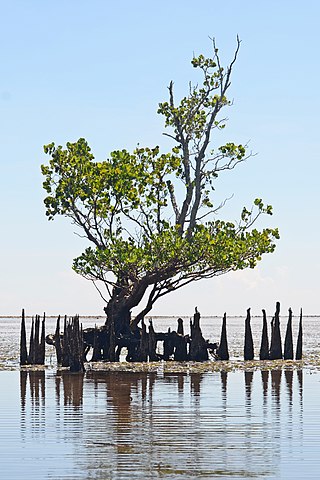
A mangrove is a shrub or tree that grows mainly in coastal saline or brackish water. Mangroves grow in an equatorial climate, typically along coastlines and tidal rivers. They have special adaptations to take in extra oxygen and to remove salt, which allow them to tolerate conditions that would kill most plants. The term is also used for tropical coastal vegetation consisting of such species. Mangroves are taxonomically diverse, as a result of convergent evolution in several plant families. They occur worldwide in the tropics and subtropics and even some temperate coastal areas, mainly between latitudes 30° N and 30° S, with the greatest mangrove area within 5° of the equator. Mangrove plant families first appeared during the Late Cretaceous to Paleocene epochs, and became widely distributed in part due to the movement of tectonic plates. The oldest known fossils of mangrove palm date to 75 million years ago.

A jungle is land covered with dense forest and tangled vegetation, usually in tropical climates. Application of the term has varied greatly during the past recent century.

The flavanonols are a class of flavonoids that use the 3-hydroxy-2,3-dihydro-2-phenylchromen-4-one backbone.
Agromyces is a genus in the phylum Actinomycetota (Bacteria).
Gordonia is a genus of gram-positive, aerobic, catalase-positive bacterium in the Actinomycetota, closely related to the Rhodococcus, Mycobacterium, Skermania, and Nocardia genera. Gordonia bacteria are aerobic, motile, and non-sporulating. Gordonia is from the same lineage that includes Mycobacterium tuberculosis. The genus was discovered by Tsukamura in 1971 and named after American bacteriologist Ruth Gordon.. Many species are often found in the soil, while other species have been isolated from aquatic environments. Gordonia species are rarely known to cause infections in humans.
Penicillium sumatrense is a species of fungus in the genus Penicillium which was isolated from the rhizosphere of the plant Lumnitzera racemosa. Penicillium sumatrense produces sumalarin A, sumalarin B, sumalarin C
Streptomyces avicenniae is a bacterium species from the genus of Streptomyces which has been isolated from the rhizosphere of the plant Avicennia marina in the Fujian Province in China.
Gordonia alkanivorans is a bacterium from the genus of Gordonia which has been isolated from soil which was contaminated with tar and phenol in Rositz in Germany. Gordonia alkanivorans has the ability to metabolize hexadecane. The strain RIPI90A of Gordonia alkanivorans can desulfurize dibenzothiophene.
Gordonia jinhuaensis is a Gram-positive, aerobic, rod-shaped and non-motile bacterium from the genus Gordonia which has been isolated from pharmaceutical wastewater from Jinhua in China.
Gordonia shandongensis is a bacterium from the genus Gordonia which has been isolated from farmland soil in China.
Gordonia sihwensis is a Gram-positive and nitrate-reducing bacterium from the genus of Gordonia which has been isolated from an autotrophic denitrification reactor in Sihwa in Korea.
Microbacterium thalassium is a bacterium from the genus of Microbacterium which has been isolated from the rhizosphere from mangrove trees on Japan.
Asanoa hainanensis is a Gram-positive and non-motile bacterium from the genus Asanoa which has been isolated from the rhizospheric soil of the fern Acrostichum speciosum from Wenchang, China.
Demequina mangrovi is a Gram-positive bacterium from the genus Demequina which has been isolated from rhizospheric soil of the mangrove plant Bruguiera gymnorhiza.
Kandeliimicrobium is a Gram-negative genus of bacteria from the family of Rhodobacteraceae with one known species. Kandeliimicrobium roseum has been isolated from rhizospheric soil from the mangrove Kandelia candel from the Mai Po Nature Reserve in Hong Kong.
Sinomonas tropicus is a Gram-positive bacterium from the genus of Sinomonas which has been isolated from the rhizosphere of a mangrove from Pramuka Island in Indonesia.
Agromyces luteolus is a bacterium from the genus of Agromyces which has been isolated from the rhizosphere and soil from the tree Sonneratia alba from Okinawa in Japan.
"Isoptericola rhizophila" is a Gram-positive bacterium from the genus of Isoptericola which has been isolated from rhizospheric soil from the tree Ficus benghalensis from the Bhitarkanika mangrove forest in India.
Zunongwangia mangrovi is a Gram-negative, rod-shaped, strictly aerobic, slightly halophilic and non-motile bacterium from the genus of Zunongwangia which has been isolated from the mangrove Avicennia marina from Tamil Nadu.
Albibacillus is a gram-negative, rod-shaped and motile bacterial genus from the family Rhodobacteraceae with one known species. Ruegeria kandeliae has been reclassified to Albibacillus kandeliae.


